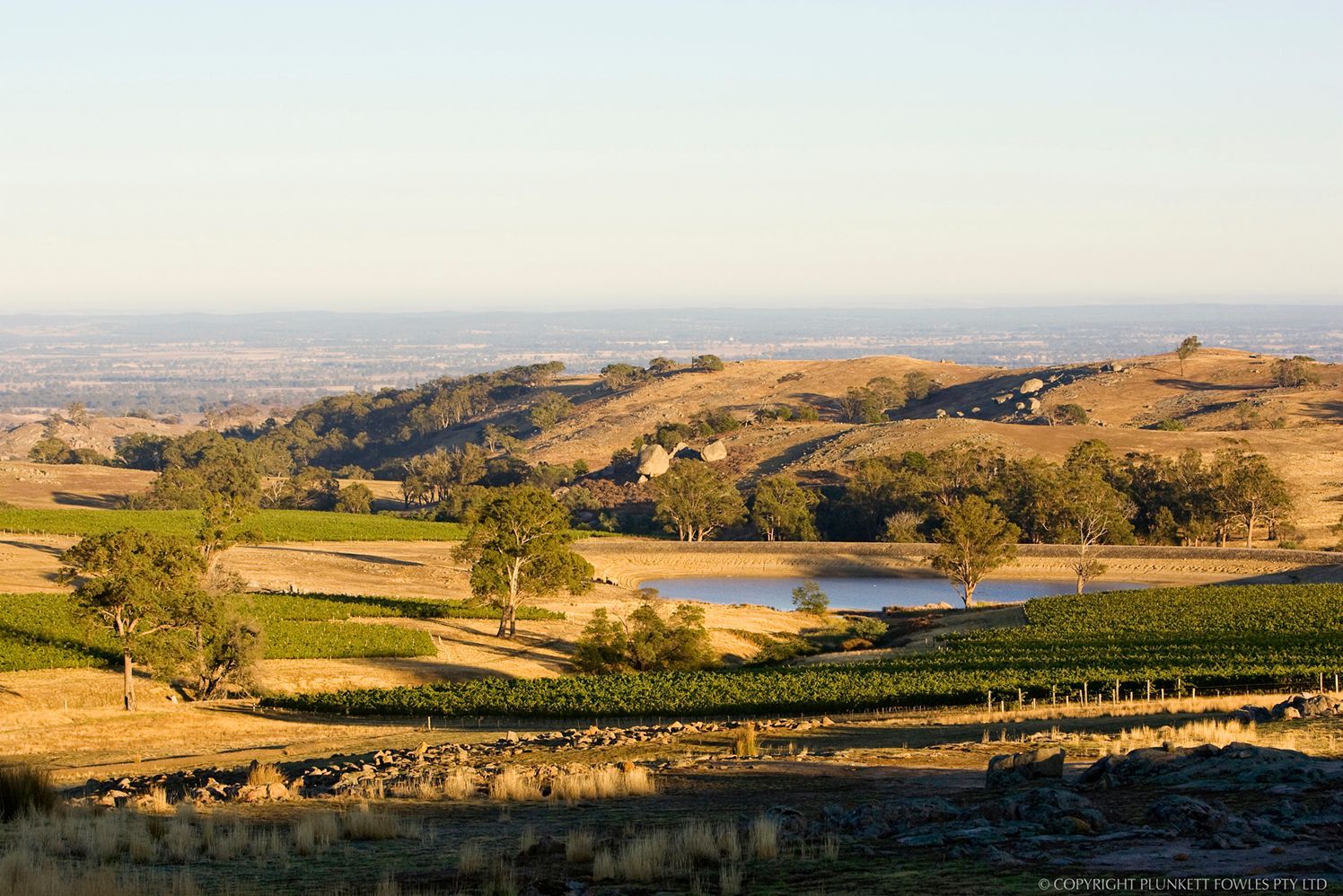Rediscovering Rutherglen
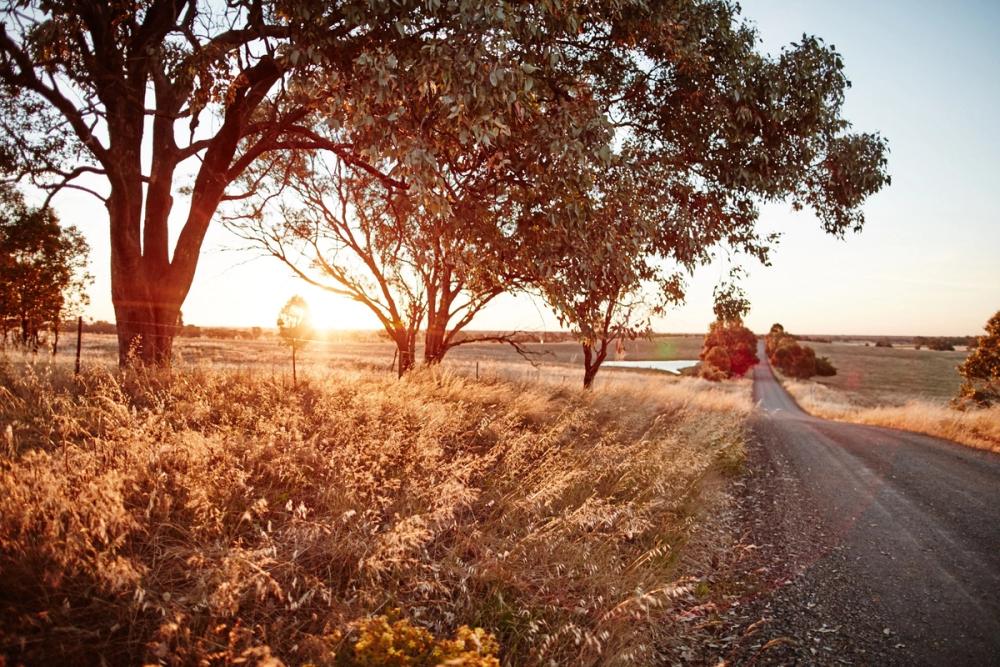
Rutherglen has been transformed as a wine region in the 20 years that Joe Wadsack last visited
I first visited Rutherglen in 2006 when I travelled to the north of the state to judge the 118th Annual Rutherglen Wine Show, with some of the finest wine tasters I have worked with: Kevin Glastonbury, the then new assistant red winemaker from Yalumba, Tempus Two’s incredible winemaker Sarah-Kate Dineen and PJ de Charteris then working at Hunter’s Brokenwood Wines, and not forgetting our host, legendary palate and show judge Chris Pfeiffer.
It’s fair to say that all of them are making wines comfortably in the top 1% of Australasia’s wines today, with Chris probably making the finest vintage fortified red wines (no, you can’t call it Port) in the country, alongside his talented daughter, Jenny, at their eponymously named wine farm, Pfeiffer Wines.
From a winemaking point of view, Rutherglen was all about fortified back then, with the odd solid, robust red wine usually made from Shiraz or Durif. Finesse wasn’t often a word that cropped up in my tasting notes. The hotels were functional, and the best food I ate was prepared and served at winemakers’ houses by resident exchange students from France and Spain.
Well, I can tell you that Rutherglen has changed. There is a consortium of winemakers that include virtually all of the founding families of Rutherglen, most of whom have relatives that can be easily traced back to the Gold Rush of the 1850s.
There is a revelatory sense of confidence about what Rutherglen is today that clearly comes from some sober and skilful decision making by the group.
Transformed
In August, I arrived in Rutherglen from Sydney. It was a beautiful cloudless day, and arriving in the high street, I found myself asking my host when we would get to Rutherglen not believing I was in the same town that I visited nearly 20 years ago.
Rutherglen is a truly gorgeous town, bursting with civic pride. Rutherglen, a shade over three hours by car from the state capita, now has a tourist wine scene and infrastructure befitting a city of Melbourne’s size and ambition. Move over Napa Valley. Northern Victoria doesn’t feel like it’s doing it just for the money. There is an authenticity about the whole experience.
Rutherglen is nestled along the Murray River, and therefore the territorial boundary of New South Wales. To the west, downstream of Rutherglen, you have the heritage wine region of Goulburn Valley and two outlier regions to the North West of the state. These are the Murray Darling and Swan Hill. They both produce every day quality wines.
Murray Darling is a winemaking powerhouse with 25,000 hectares of vines, shared amongst thousand growers.
The best-known wines in the UK would be from Trentham Estate and Deakin Estate from the Victoria side of the river. Andrew Peace produces wines in the relatively diminutive Swan Hill district, which due to being slightly higher, more continental and less exposed, is a little cooler and less prone to disease pressure compared to Murray Darling.
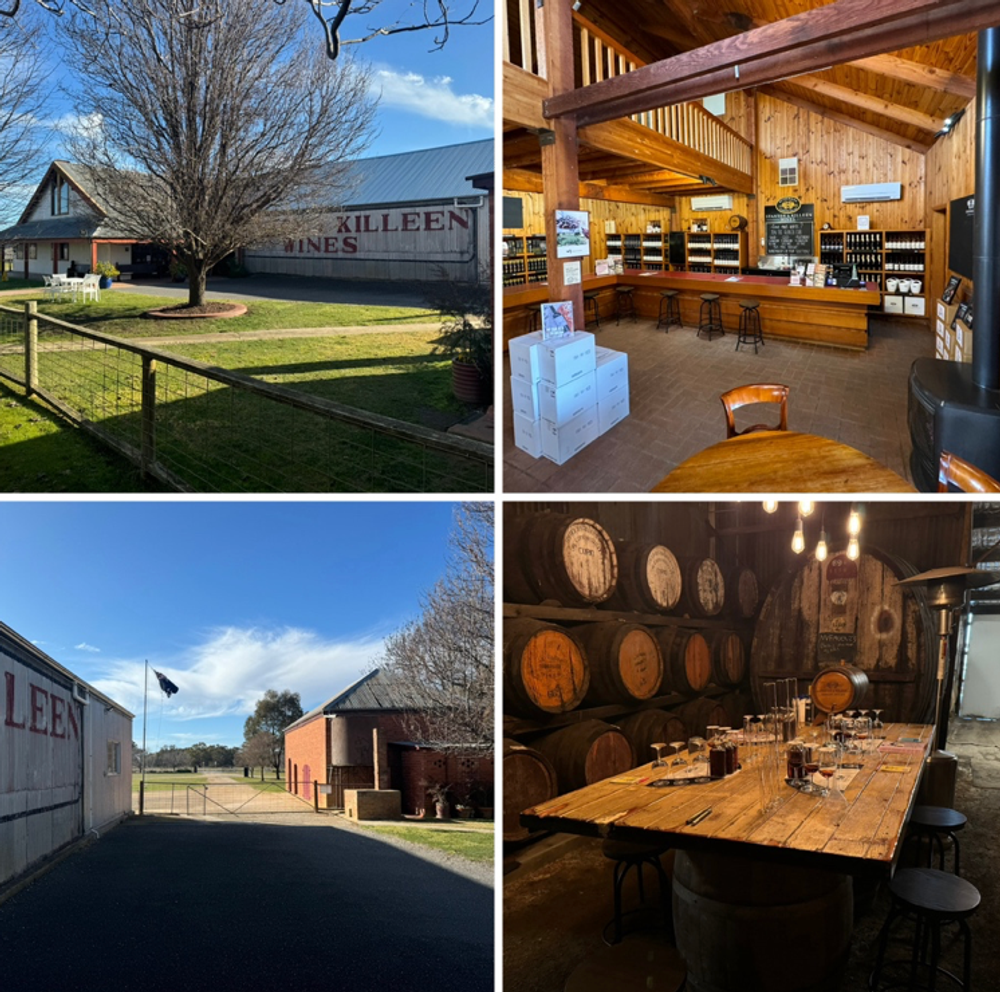
Stanton and Killeen Wines
I have been fortunate to have been asked to judge the Royal Melbourne Wine Show three times between 1999 and 2013. Over that time, I have witnessed many changes: from producing highly extracted, heavily oaked red wines to lighter more elegant less oak dominated wines, and more pertinently, the dramatic reduction in the number of fortified desserts wines in sherry and port styles.
Mighty fortifieds
There isn’t a book written about the subject that doesn’t extoll the world class qualities of the magical sweet fortified wines of Rutherglen and Glenrowan, but in an era where sweet foods of any kind are treated with caution, it is important to support the endeavours of the remaining few artisans keeping these styles alive and, with the huge global surge in popularity of Port and Madeira, surely these wines have a chance?
Chris Killeen carved out an enviable reputation for these incredible fortified wines and was considered ahead of the curve when he produced a VP (and accepted Australian moniker for Vintage Port style) in 1997 entirely from Portuguese varieties imported from the Douro at Stanton & Killeen. Since his passing, Wendy Killeen, his wife and Natasha their daughter have since decided with such an evidently suitable climate to plant and specialise in Portuguese-derived table wines too. They have invested in white varieties too, such as Alvariño, Arinto and Antão Faz, with dazzling results.
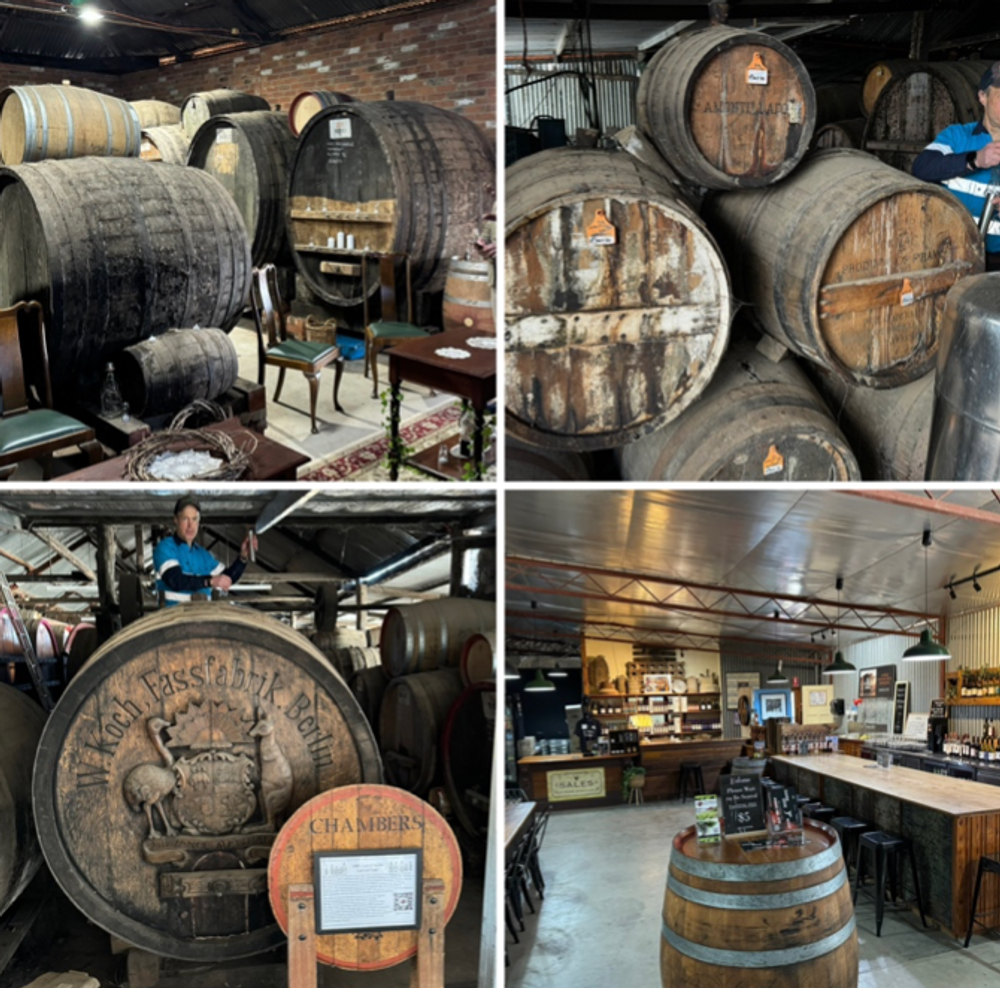
Behind the scenes at the magical Chambers Rosewood Winery
Sadly Bill Chambers passed away this summer, weeks before I had a chance to return and pay my respects to one of the finest show chairs I had ever met. He was chair of the Royal Melbourne Wine Show in 1999 when I was first invited to judge.
Stephen, his son, is in sole charge now of Chambers Rosewood Vineyards. They were both described by Robert Parker as “nothing short of national treasures”. He was right. Their cellar is place of magic. It feels like a drinks warehouse from Diagon Alley in the Harry Potter books. I noticed old Muscat stored in Courvoisier Cognac barrels. Steve said that his great grandfather would have to get barrels however he could find them, and shipping Cognac in whole barrels from France was one way, which would give some indication to how old some of his wines stocks are.
In my opinion, of all the fortified Muscat and Muscadelle (Topaque) producers left, Chambers is the most poetic. There are bigger more intense wines, like Mick Morris, but for elegance and pure beauty, Stephen and his late dad have been responsible for making some of the finest sweet wines on earth.
All Saints Estate

A must visit place is the castle at All Saints Estate. It has one of the finest restaurants in the state, but is also a living museum with preserved Chinese dormitories used by miners and agricultural workers 180 years ago. Owned by a branch of the Brown family, it is beautifully put-together cellar door/wine bar and food complex, with some fine liqueur muscats, including the one in the picture, claimed to be 100 years old, and which scored 100 points in James Halliday’s annual wine guide. Yes, it was sublime.
Before leaving Rutherglen, Rowly and Sally Milhinch of Scion Wine deserve a big mention. They have taken every traditional grape variety and wine style and flipped it on its head. They make a whole bunch of delicious Durifs and Muscats, some bone dry, others rosé, and a stunning Viognier. Please look them up.
They are a periscope view into what might become common practice over the coming years. Change is coming.
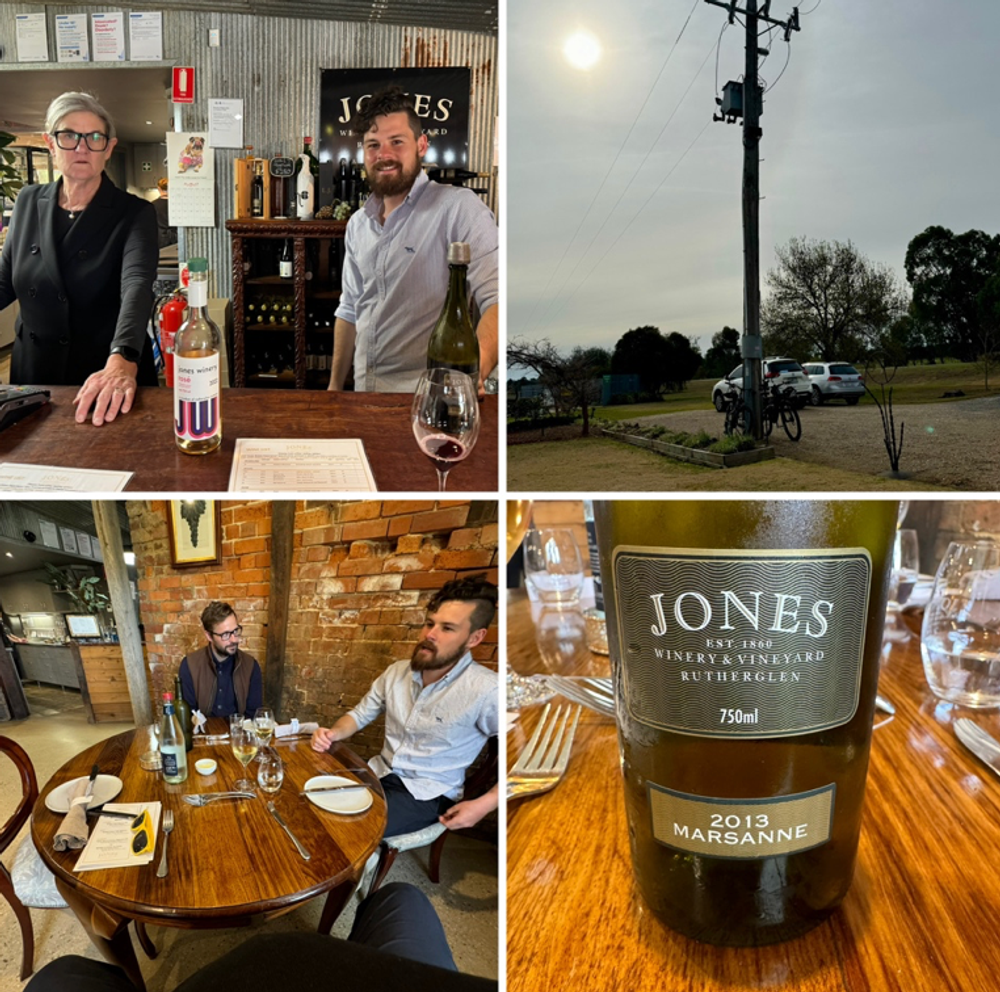
The Jones Winery
Even Jones Winery, which is officially one of the 10 oldest wineries in the country, currently managed by Arthur, his son Ben and Mandy Jones (who I made wine with at Chateau Carsin in Bordeaux back in 1991) is trying its hand at vermouth, dry Muscat and a rather nice sparkling Marsanne.
Final word, if it is giant red wines full of flavour, alcohol and very long futures, Warrabilla Wines also needs a mention. Wines grown and made by Andrew Sutherland-Smith or “Smithy“ to his mates, he makes some of the biggest wines in the world with Durif, Shiraz and Grenache.
These wines are AC/DC in a glass. Huge, full flavoured wines with remarkable freshness, finesse and balance. They have a cult following and over 90% of his wine is sold through cellar door or through his wine club. Watch out for the brilliant 2024 wines. Immense and incredible value.
Victoria’s North East – Glenrowan and Beechworth
Let’s take a look around the North East of Victoria at adjacent wine districts. Firstly Glenrowan is very much from the same gene pool as Rutherglen, with some extraordinary fortified “stickies’ made by Baileys of Glenrowan, along with some of the most robust and heavyweight shirazes in the region.
Heading south from Rutherglen, head through the town of Wangaratta, you will find yourself in the the small but internationally renowned region of Beechworth. It is Victoria’s smallest wine zone, but with some incredible wines. It was first put on the map by Chardonnay producer Giaconda, then Sorrenberg and some cult wines from small handmade producer, Pennyweight. The region continues to grow rapidly, with fantastic producers such as Savaterre, Fighting Gully Road and Castagna. These are truly stunning, riveting, minerally charged wines with few Australian or even worldly equals. Their quality is reflected in their price.
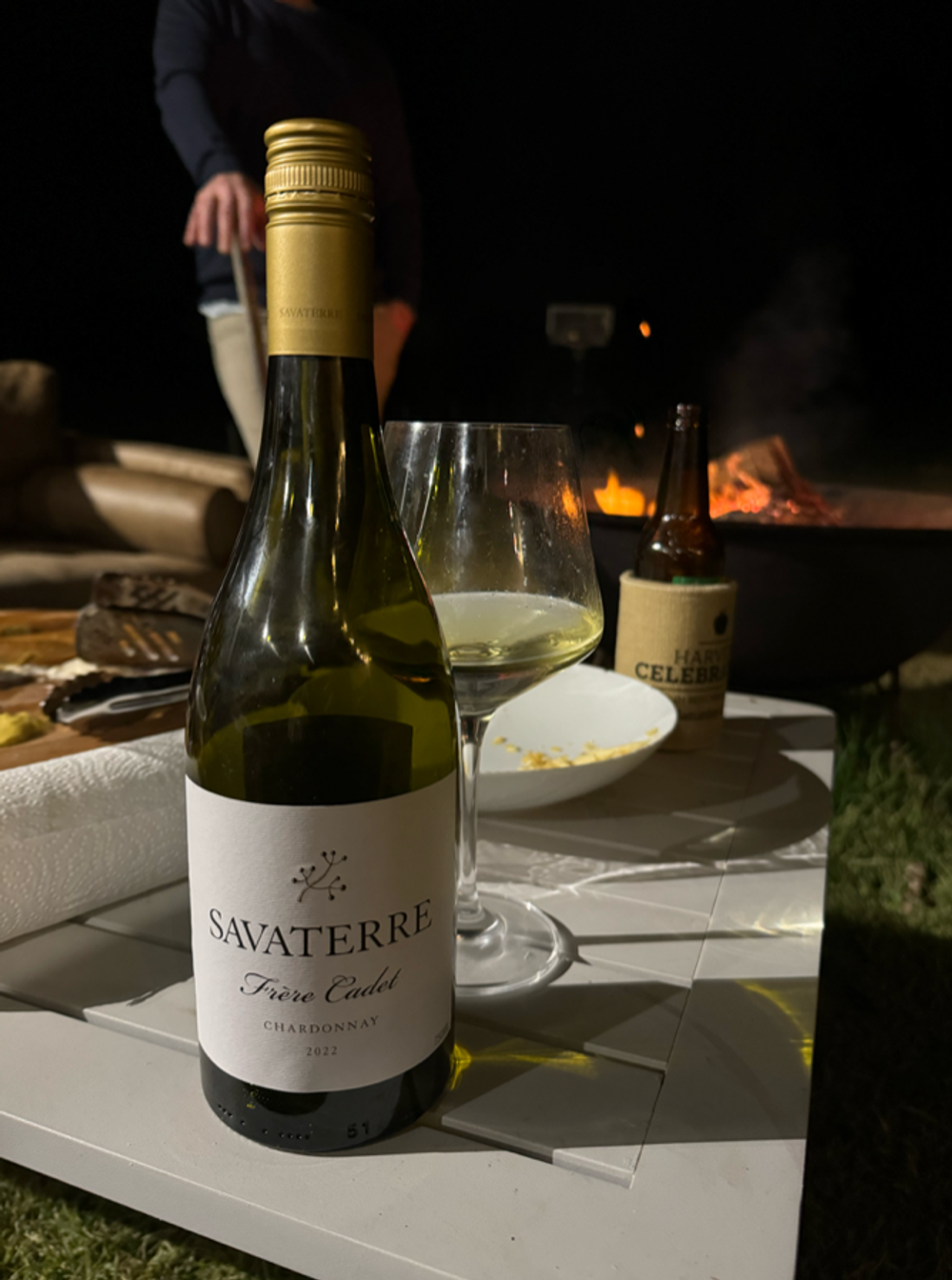
Drinking Beechworth Chardonnay around a firepit barbecue in Wangaratta
Alpine Valleys
The Alpine Valleys surround Beechworth to the south and contain some of the most beautiful wine vistas in the state, along with some of the finest ‘powder’ and ski-fields in the country. The wineries clearly benefit from the footfall of ski tourists, but a few estates certainly have a big enough reputation to be destinations in their own right, namely Gapsted Estate and Billy Button Wines, which Jo Marsh and the team are taking to new levels for the region.
Upper Goulburn
The Upper Goulburn region south of King Valley has a similar story, with a lot of tourism brought to the national park by Mouth Buller, one of the closest and most reliable ski resorts to Melbourne during winter. Here, one estate, Delatite Wines, has built a reputation for its aromatic whites, made from Riesling and Gewürztraminer and also makes some elegant reds. Ros Ritchie who was reponsible for amazing pioneering work with these varieties there from the late eighties until the 2000s now has her own estate and wines in Mansfield.
King Valley
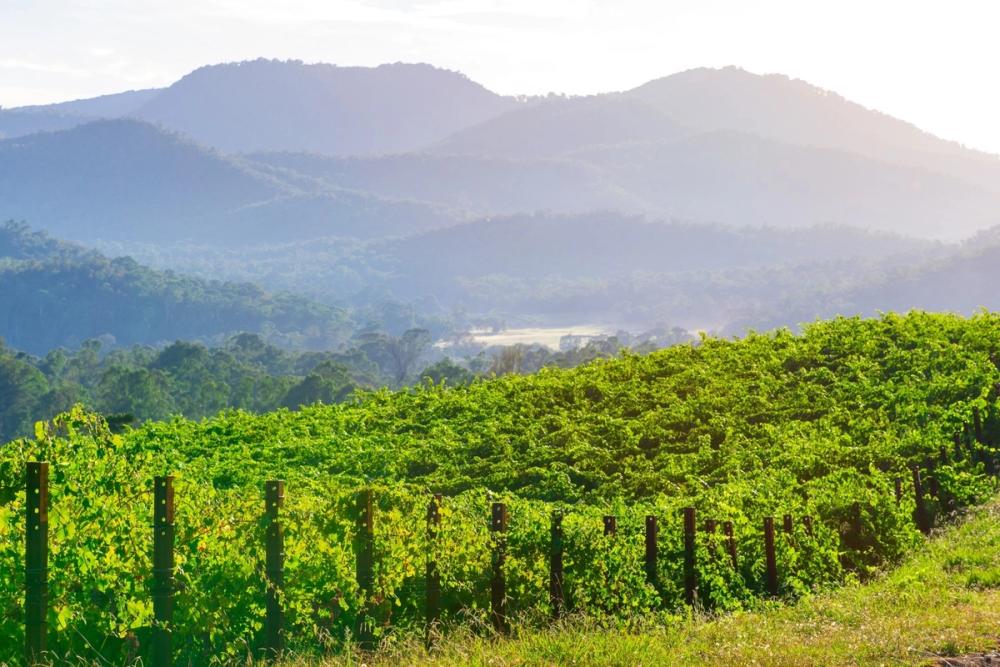
The King Vallley region
Although I didn’t have the time to visit King Valley this time, how important this grape growing region has been in the development of Victorian wine over the past 70 years cannot be underestimated. When Beaujolais couldn’t be given away in the UK, and Alsatian wine sales were in an all-time English slump, we were queuing up by the hundreds to get our Brown Brothers Tarrango and Dry White Muscat for the weekend barbecue, not to mention the Orange Muscat and Flora to go with our summer puddings.
These wines were everywhere. Its altitude and alpine protection guaranteeing regular unbroken sun means that it is pretty perfect for grape growing. Although Merlot is grown in surprising quantities here, it’s the names of the farms that give away King Valley’s Italian wine farming roots.
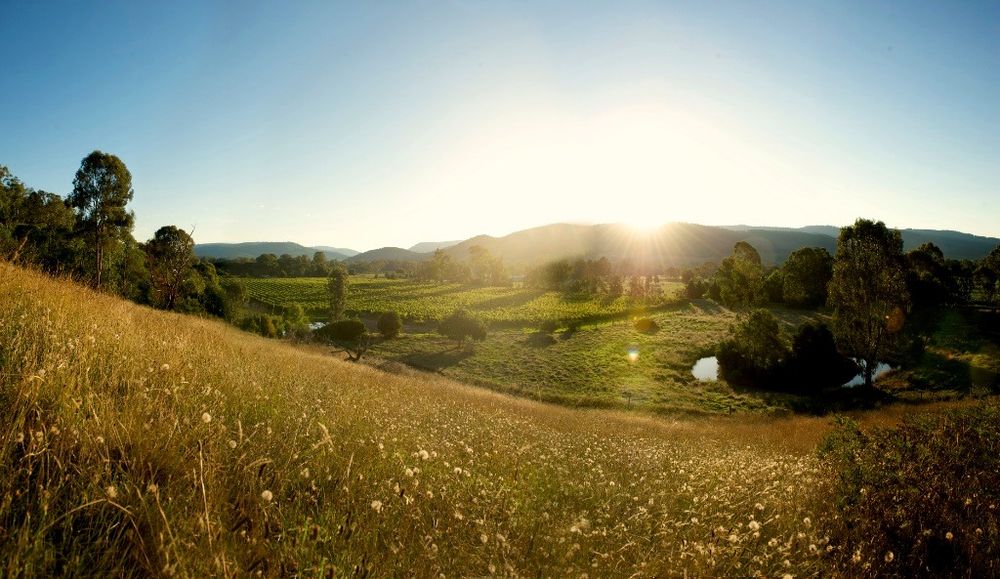
Dal Zotto's vineyards
Dal Zotto and Pizzini have been churning out delicious Sangiovese, Nebbiolo and Barbera for decades. This is also the hub of the Prosecco industry in Australia. It is hard to impress on the English how successful and substantial the Prosecco culture is in Australia.
Strathbogie Ranges
The Hume Freeway cuts Strathbogie Ranges in half longways. After Seymour on the way to Shepparton you cannot fail to notice Fowles’ gorgeous, industro-chique restaurant and winery with its floor-to-ceiling windows and distinctly Californian vibe. Food is truly delicious and this is a dining room that you could spend the whole day in. Matt Fowles is an enthusiastic hunter and feels strongly about the “farm and nature to table” ethic of his restaurant.
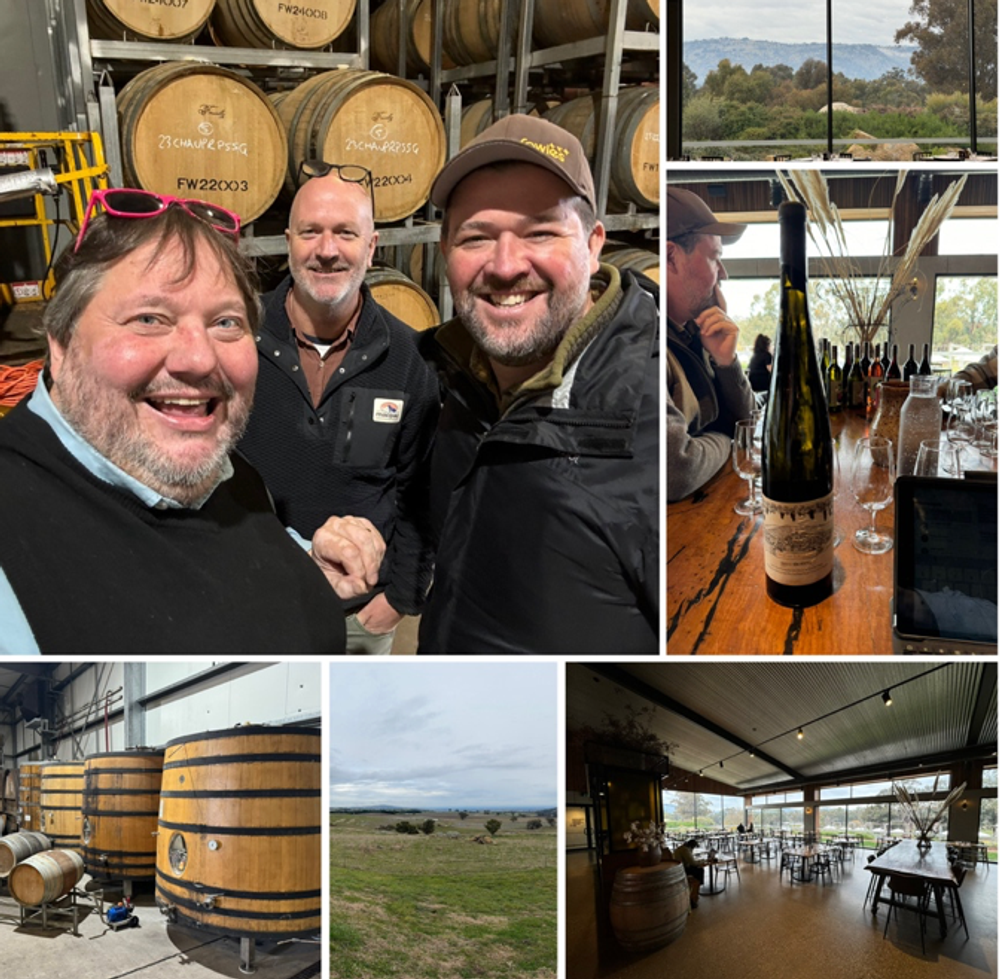
Matt Fowles on the right, and Matt Harrop in the centre, with Joe Wadsack at Fowles Winery
Apparently he started, simply wanting to make wines that were better suited to wild game than what WBA’s available. He makes some beautiful wines, and is set to make even better wines having recruited superstar winemaker Matt Harrop from Curly Flat. My favourite wine is their full throttle Chardonnay, Ladies who Shoot Their Lunch, but watch this space as he is investing considerable time and money on some special Riesling and Gamay vineyards, which show great promise here.
Goulburn Valley
As you leave the steep hills of Strathbogie Ranges, heading North again on the Hume Freeway, you soon find yourself in Nagambie Lakes, the southernmost GI of Goulburn Valley. It positively wreaks of nostalgia here: warm open vineyards, the swamp lands of River Goulburn’s watershed, creosoted timber buildings and ancient looking vines. It’s warm here in summer and due to high concentrations of alluvial sand, some vines survived the scourge of phylloxera, and vineyards survive that were planted in the 1860s.
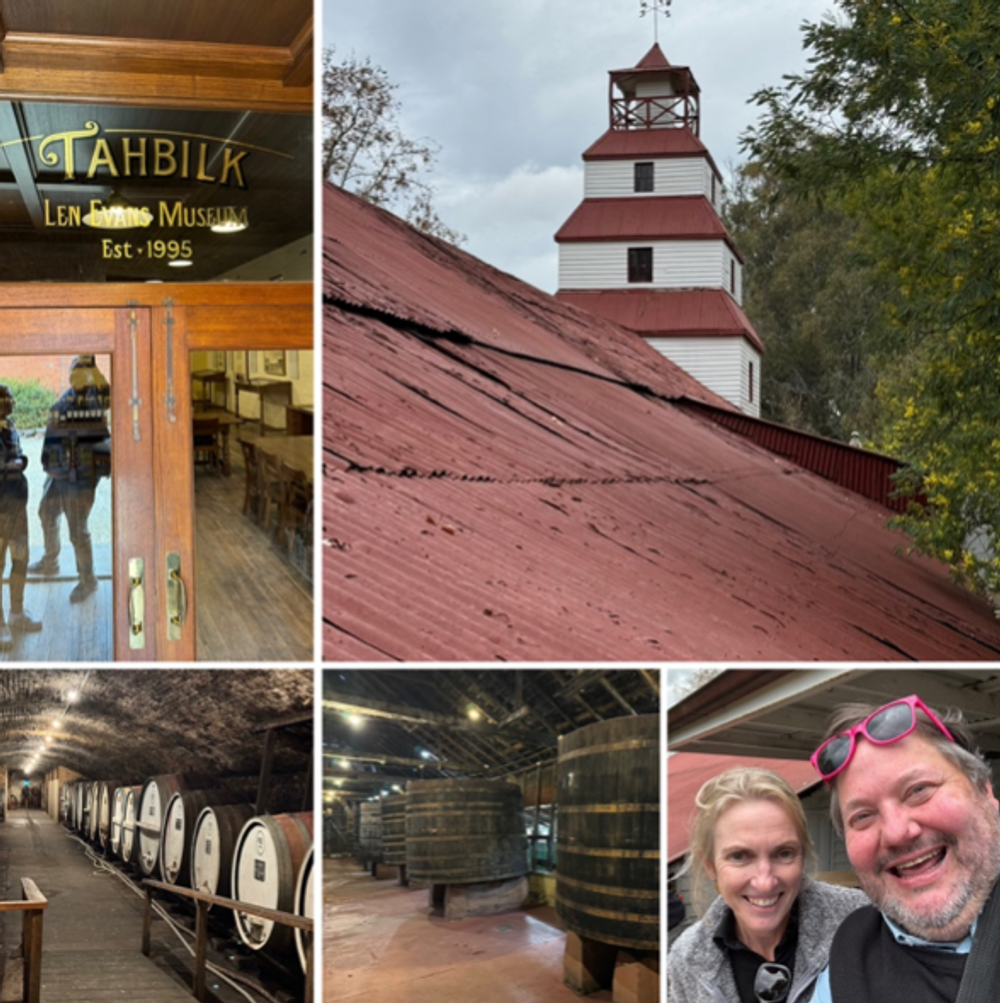
At Tahblik with Jo Nash
Tahbilk is truly a living museum, that has made some of the finest Australian wines of all time under the watchful eye of winemaking legend Eric Purbrick, and later his son, Alister, who is still alive today. Jo Nash is now chief winemaker and general manager at the winery these days, still making stupendous Marsanne at various quality levels, something Tahbilk is renowned for. The Old Vine Cabernet Shiraz is also a steal.
After an evening with my chum, Simon Lee, former landlord of my Chelsea local, the Coopers Arms on Flood Street, and now brand manager for fabulous Syrah, Nebbiolo and Riesling maker, Tar & Roses, we headed to Mitchelton for a decadent stay at Mitchelton Estate.
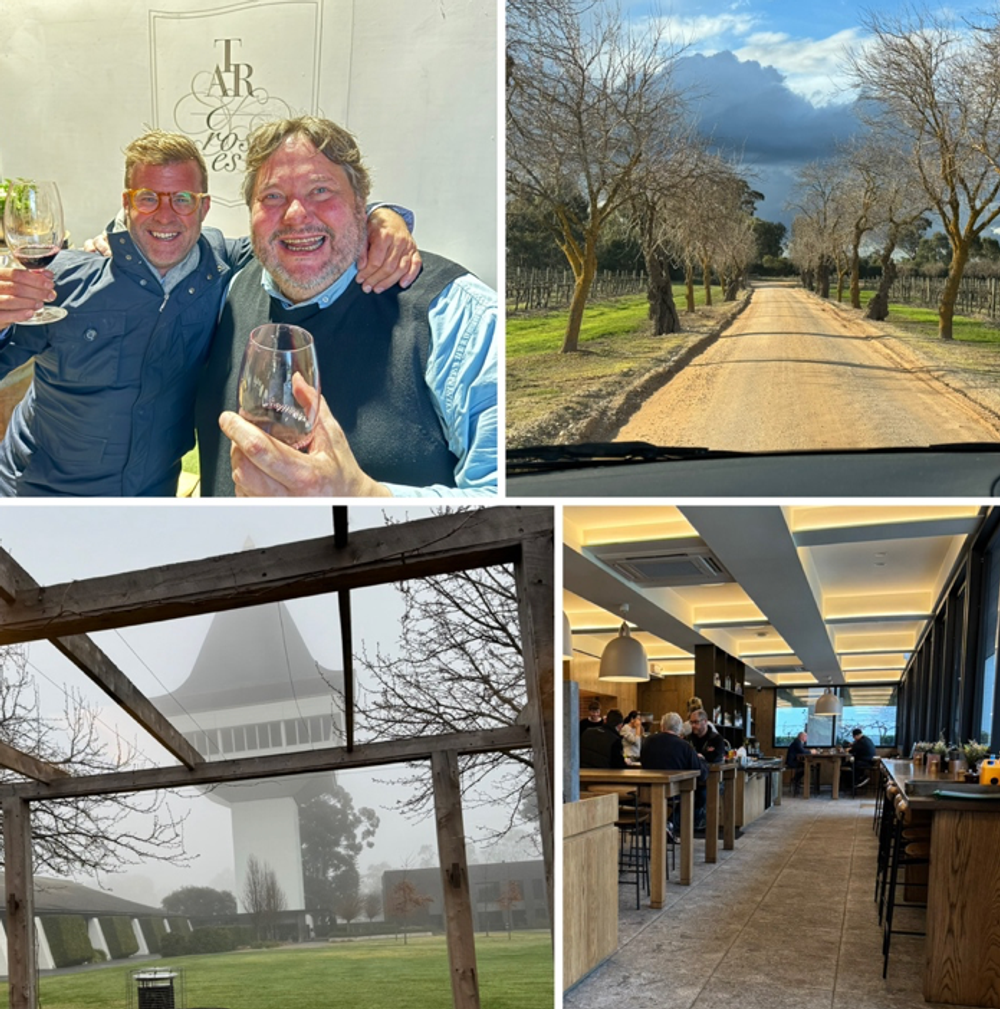
Joe Wadsack and Simon Lee at Mitchelton Estate
For the next and final part, I will be exploring the regions that brought world class Pinot Noir and Chardonnay from Victoria to the world, namely Geelong, Gippsland, Mornington Peninsular and Yarra Valley.
* You can read the first part of Joe Wadsack's report on Victoria wine here.
* You can find out more about the region at Wine Victoria website here.
